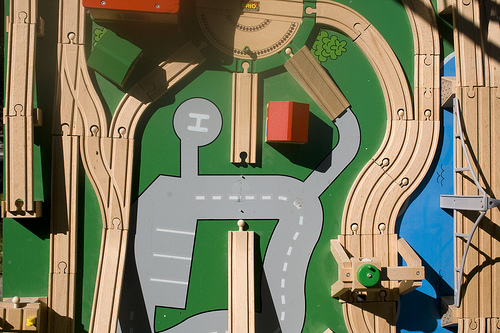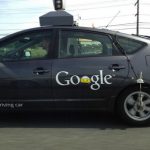USDOT’s grim report on transportation in 2045
The U.S. Department of Transportation paints a depressing picture of America’s future transportation landscape in a recent report, Beyond Traffic, Trends and Choices: 2045. The report is part of a larger Beyond Traffic initiative launched by U.S. transportation secretary Anthony Foxx and Google CEO Eric Schmidt. Some of the low-lights? >As The Stack puts it, we can look forward to “airports underwater, unmaintained bridges and roads in catastrophic decay, bursting trains unable to stop at most stations and LA-style traffic-jams in Nebraska.”

USDOT on what American transportation will be like in 30 years: “Don’t expect the Jetsons, people.” Image from woodleywonderworks.
The initiative doesn’t set out to solve these problems, but it does offer a few strategies, and, even more importantly, it sheds light on their implications. The 316-page report is divided into three parts: Trends (How We Move; How We Move Things; How We Move Better; How We Adapt; and How We Align Decisions and Dollars); System Implications (exploring the impact on highways, cars, transit, pedestrians and bikes, aviation, intercity rail, pipelines, and marine transit); and, lastly, Shaping Our Future: Choices in Changing Times, which presents different scenarios of the future, and examines case studies and initiatives — such as New York City’s climate change panel, and Portland’s strategic transit plan.
The U.S.’s transportation system once ranked as one of the world’s greatest, but the infrastructure that supports it is both decaying and expanding at the same time. “Our transportation network is the tie that literally binds our nation together. It sows the seeds of economic opportunity and national prosperity one row at a time, and links those rows to each other—neighbor to neighbor, town to town, state to state, all into one nation,” reads the report. “But it is aging and increasingly incapable of bearing the load our future demands.”
As the report explains, the country’s existing system is “proceeding under a 20th century model,” and floundering — especially over the last six years — under financial uncertainty, falling-apart infrastructure, and a lack of unified policy, leaving “the United States on the precipice of losing its historical advantage in moving people and things faster, safer, and more reliably than any other nation in the world.” A predicted uptick in U.S. population by 70 million over the next 30 years also means that we aren’t investing enough to maintain — much less improve — existing infrastructure.
Other disastrous events — which the report notes are “possible snapshot[s]”, not necessarily forecasts — include climate change causing a number of airports to sink below sea level; highway congestion rising from its existing 11% to 37%; and an overextended pipeline capacity due to increased domestic oil and natural gas production.
The report also considers rideshare and carshare trends, which provide mixed blessings; while the sharing economy can help supplement existing transit, it will also challenge existing systems: “Over the next 30 years, our legal and regulatory system may be increasingly challenged by emerging forms of business and travel that transcend traditional legal and planning concepts.” Another key development that stands to impact transportation policy is changing commuting habits — namely increased telecommuting, and an aging population that will have different transportation needs, “the most influential factors affecting commuter travel.”
It isn’t all doom and gloom, however. Smart technology and other developments out of Silicon Valley, such as Google’s autonomous car, coupled with studying the trends outlined by the report will give us an increased ability to address the choices we’re confronted with, as the report explains: “We will make our choices one stitch at a time, in state capitals, city halls, corporate boardrooms and union halls. All of them, put together, reflect where we will go. The future is always a choice.”
Related Posts
Category: Transportation

















